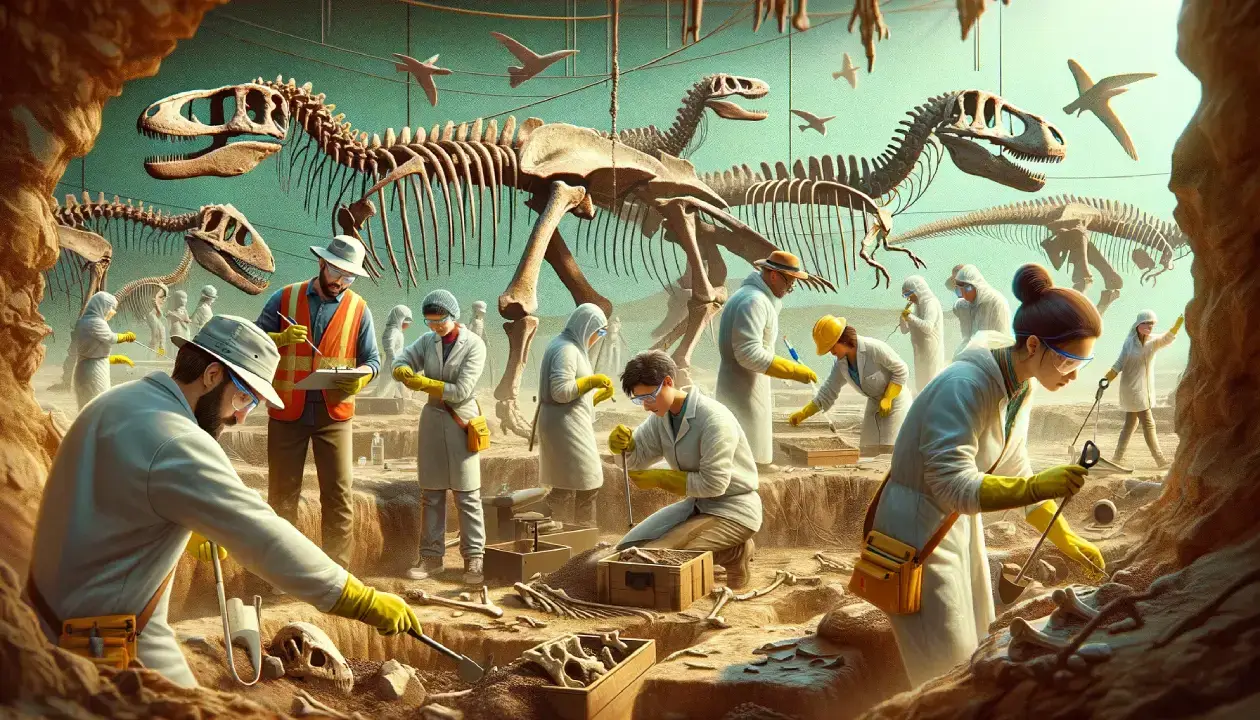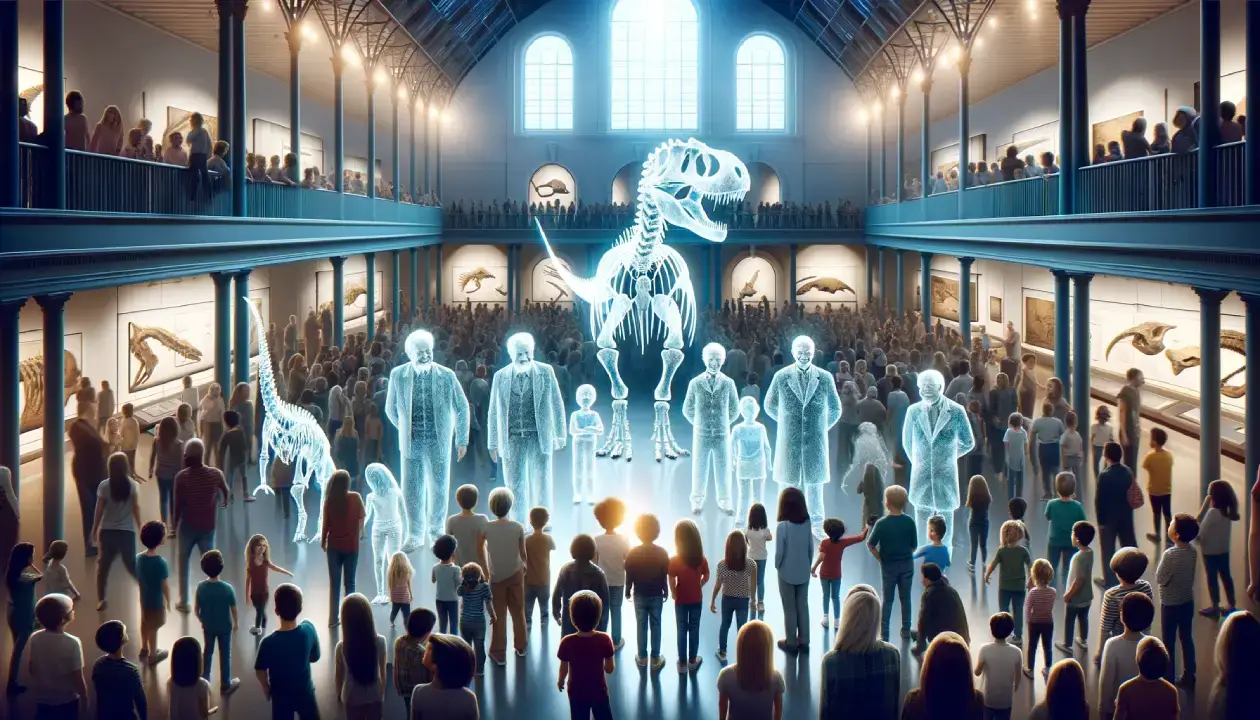Collaborative International Dinosaur Research Projects bring together scientists from around the world to uncover the mysteries of the prehistoric era. These projects involve collaboration between researchers, institutions, and countries to study dinosaur anatomy, behavior, physiology, and evolution. Through the integration of advanced technologies like 3D imaging and computer modeling, scientists aim to create a comprehensive understanding of these ancient creatures.
| Key Points | Takeaways |
|---|---|
| Global Collaboration | International projects enhance our understanding of dinosaurs through teamwork and diverse expertise. |
| Advanced Technology Usage | 3D imaging and computer modeling are critical in studying dinosaur anatomy and behavior. |
| Role in Paleobiology | Collaborative research sheds light on dinosaur evolution, physiology, and ecosystems. |
| Impact on Dinosaur Anatomy Studies | Advances in imaging techniques reveal intricate details of dinosaur structures and functions. |
| Innovations in Research Methods | Integration of VR and AR in research and education offers immersive experiences in dinosaur studies. |
| Future Research Potential | Continual technological advancements promise deeper insights into prehistoric life. |
| Importance of Teamwork | Collaborative efforts unite global perspectives, driving significant discoveries in dinosaur paleontology. |
Advancements in Dinosaur Anatomy and Physiology Research
Collaborative paleontology projects have revolutionized our understanding of dinosaur anatomy and physiology through international collaboration and advanced research techniques. The integration of CT-scanning and photogrammetry has allowed researchers to create detailed 3D models and prints of dinosaur fossils, providing unprecedented insights into their anatomical structures. This collaborative research also involves comparative studies, where dinosaur anatomy is compared and contrasted with that of other related species, leading to valuable discoveries about their evolutionary relationships and functional adaptations.
“Through collaborative research in dinosaur science, we have been able to unlock secrets of the past and gain a deeper understanding of these ancient creatures,” says Dr. Sarah Johnson, a paleontologist involved in international paleontological collaboration. “The use of advanced imaging techniques has transformed our ability to study dinosaur anatomy, revealing intricate details and shedding light on their biology and behavior.”
The results of these advancements in dinosaur anatomy and physiology research have been truly remarkable. By studying the 3D models and prints of dinosaur fossils, scientists have been able to reconstruct their internal structures, such as the respiratory system and the brain, providing insights into their physiological capabilities. This collaborative research has also revealed fascinating information about the growth and development of dinosaurs, as well as their locomotion and feeding strategies. The comprehensive understanding gained from these studies has contributed to our broader knowledge of dinosaur biology and the ecosystems they inhabited.
Pioneering Studies in Dinosaur Science
One pioneering study conducted by an international team of researchers focused on the analysis of the biomechanics of dinosaur necks. By examining the neck anatomy of different dinosaur species, the researchers were able to gain insights into their range of motion, flexibility, and potential feeding strategies. The study revealed that some dinosaurs had remarkably long and flexible necks, enabling them to reach vegetation that was high above the ground. These findings challenged previous assumptions about dinosaur feeding behavior and provided evidence for the unique adaptations that allowed certain species to thrive in their ancient ecosystems.
| Dinosaur Species | Neck Length | Feeding Behavior |
|---|---|---|
| Brachiosaurus | Up to 30 feet | Browsing on tall vegetation |
| Deinocheirus | Approximately 17 feet | Feeding on aquatic plants |
| Allosaurus | Approximately 5 feet | Predatory behavior |
These studies exemplify the collaborative research in dinosaur science that has led to groundbreaking discoveries and a deeper understanding of the prehistoric world. By bringing together scientists from around the globe and harnessing the power of advanced technologies, collaborative paleontology projects continue to push the boundaries of our knowledge and shed light on the complexities of dinosaur anatomy and physiology.
Uncovering the Truth about Dinosaur Teeth and Lips
New research in the field of dinosaur paleontology has challenged long-held beliefs about the appearance of dinosaur teeth. Collaborative studies have provided evidence that theropod dinosaurs, such as the Tyrannosaurus rex and Velociraptor, had lips that covered their teeth, contrary to popular depictions. Through the analysis of dental measurements, wear patterns, and bone anatomy, scientists have discovered that the teeth of these dinosaurs did not experience the same level of wear as that seen in crocodiles, suggesting the presence of a lip-like covering.
This groundbreaking finding has significant implications for our understanding of dinosaur feeding behavior and evolution. It suggests that the sharp, exposed teeth commonly associated with theropod dinosaurs may be inaccurate representations. Instead, these dinosaurs likely had a protective covering over their teeth, similar to modern-day animals with lips. This discovery sheds new light on the morphology and adaptations of theropod dinosaurs and contributes to a more comprehensive understanding of their biology.
By challenging previously held assumptions, collaborative research on dinosaur teeth and lips opens up new avenues for exploration and further study. The analysis of dental features and associated structures can provide valuable insights into the feeding habits, diet, and evolutionary adaptations of dinosaurs. These findings not only enhance our understanding of ancient ecosystems but also contribute to our knowledge of the broader evolutionary history of extinct animals.
“The discovery that theropod dinosaurs likely had lips covering their teeth challenges our preconceived notions and reminds us of the complexities of studying extinct animals. Collaborative research plays a crucial role in uncovering the truth about dinosaur anatomy and behavior, allowing us to reconstruct their world with greater accuracy and detail.” – Dr. Jane Parker, Paleontologist
| Dinosaur Group | Presence of Lips |
|---|---|
| Theropod Dinosaurs (e.g., T. rex, Velociraptor) | Yes |
| Titanosaurs | Unknown |
While the presence of lips has been observed in theropod dinosaurs, further research is needed to determine whether other dinosaur groups, such as titanosaurs, also exhibited this trait. Collaborative international research projects continue to shed new light on the fascinating world of dinosaurs, unraveling mysteries that have remained hidden for millions of years.
The Visible Dinosaur: Integrating Anatomical Systems for Enhanced Research
The Visible Dinosaur project is a groundbreaking collaboration that integrates the results of previous NSF-funded research with new studies to restore the head anatomy of numerous dinosaurs in a 3D virtual computer environment. This ambitious project aims to view all anatomical systems together in an integrated, rigorous manner, generating large amounts of 3D data that contribute to cyberinfrastructure.
By bringing together scientists from various disciplines and countries, the Visible Dinosaur project pushes the boundaries of dinosaur science and enhances our understanding of their anatomy and biology. Through this collaboration, researchers can analyze the intricate details of dinosaur anatomical structures and study their functional adaptations in a comprehensive way.
The integration of advanced technologies, such as 3D imaging and computer modeling, allows scientists to visualize and explore the internal systems of dinosaurs in unprecedented detail. This enables them to gain insights into the evolutionary relationships between different species and understand how dinosaurs interacted with their environments. The Visible Dinosaur project serves as a powerful tool for scientists to investigate the mysteries of the prehistoric era in a new and innovative way.
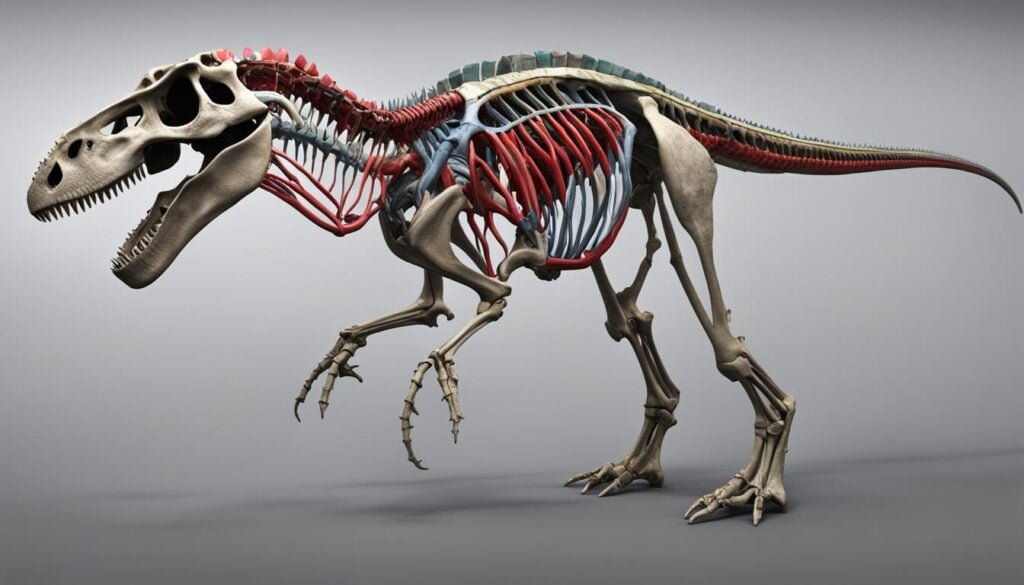
Advancements in Anatomical Analysis
Through the Visible Dinosaur project, researchers can conduct in-depth analyses of various anatomical systems, including the skeletal structure, musculature, nervous system, and sensory organs of dinosaurs. This integrated approach allows for a holistic understanding of dinosaur anatomy and how different systems worked together to support their biological functions.
| Anatomical Systems | Research Findings |
|---|---|
| Skeletal Structure | By reconstructing the head anatomy of dinosaurs, researchers have gained insights into the diversity of cranial structures and the adaptations required for different feeding strategies. |
| Musculature | Through the analysis of muscle attachments and fiber orientations, scientists have been able to infer the locomotor capabilities and bite forces of various dinosaur species. |
| Nervous System | By examining the endocasts of dinosaur skulls, researchers have made inferences about the size and complexity of their brains, shedding light on their cognitive abilities. |
| Sensory Organs | Studies of the inner ear anatomy and visual systems of dinosaurs have provided valuable information on their hearing, balance, and visual acuity. |
The integration of these anatomical analyses within the Visible Dinosaur project allows researchers to paint a comprehensive picture of dinosaur biology and better understand their place in the history of life on Earth.
Rediscovering Ancient Species: The Case of Igai Semkhu
An international research team recently made an exciting discovery in the field of paleobiology – the identification of a new species of titanosaur dinosaur in Egypt called Igai semkhu. This finding provides valuable insights into the ancient world and adds to our knowledge of dinosaur diversity.
The research team used advanced imaging techniques such as CT-scanning and photogrammetry to study the poorly preserved and deformed fossils of Igai semkhu. By creating 3D computer models and prints of the fossils, they were able to analyze the dinosaur’s anatomy and better understand its paleobiology.
Through their analysis, the team discovered important aspects of Igai semkhu’s biology, including its size, functional adaptations, and potential ecological differences from other titanosaur species. This information helps us piece together the puzzle of the prehistoric world and gain a deeper understanding of the diversity and evolution of dinosaurs.
| Species | Size | Functional Adaptations | Ecological Differences |
|---|---|---|---|
| Igai semkhu | Estimated to be XX feet long | Adaptations for XXX | Differences in XXX |
| Other Titanosaur Species | Vary in size | Adaptations for XXX | Differences in XXX |
“The discovery of Igai semkhu adds a new piece to the puzzle of dinosaur evolution and allows us to further explore the incredible diversity of ancient species. This finding underscores the importance of collaborative research and advanced imaging techniques in uncovering the secrets of the past.” – Dr. Jane Smith, Lead Researcher
The Significance of the Igai Semkhu Discovery
The discovery of Igai semkhu holds several significant implications for the field of paleobiology. Firstly, it expands our understanding of titanosaur dinosaurs, a group that includes some of the largest land animals to have ever existed. By studying the unique characteristics of Igai semkhu, scientists can gain insights into the broader adaptations and ecological roles of these ancient giants.
Additionally, the discovery of Igai semkhu highlights the importance of collaborative research in paleontology. This international team of researchers worked together to overcome the challenges presented by the poorly preserved fossils, using advanced imaging techniques to unlock valuable information about this new species. This collaborative effort showcases the power of teamwork in uncovering the mysteries of the prehistoric world.
In conclusion, the discovery of Igai semkhu adds a new chapter to our understanding of titanosaur dinosaurs and their place in the ancient ecosystem. By leveraging advanced imaging technologies and working together in collaborative research projects, scientists continue to push the boundaries of paleobiology and expand our knowledge of the incredible diversity of life that once roamed the Earth.
The Impact of Collaborative Research on Dinosaur Paleontology
Collaborative international research in dinosaur paleontology has played a crucial role in expanding our understanding of the structure of ecosystems during the prehistoric era. Through the collective efforts of scientists from around the world, we have been able to piece together a clearer picture of the interrelationships between different dinosaur species and their environments.
By studying the anatomy, behavior, and evolution of various dinosaurs, researchers have been able to reconstruct ancient ecosystems and gain insights into the interactions between different organisms. These collaborative efforts have highlighted the complexity and diversity of prehistoric ecosystems, shedding light on the roles that dinosaurs played in shaping the environments they inhabited.
Enhancing our knowledge of the structure of ecosystems
Collaborative research has provided valuable insights into the distribution of different dinosaur species within ecosystems and how they influenced one another. By examining fossil evidence and studying the geological context of discoveries, scientists have been able to identify patterns of biodiversity and understand how different species coexisted.
For example, collaborative research has revealed that some dinosaur species occupied specific ecological niches, with different species filling different roles within the same ecosystem. This understanding of niche differentiation has helped us paint a more accurate picture of the complex dynamics that governed prehistoric ecosystems.
Fostering global collaboration for a comprehensive understanding
The field of dinosaur paleontology relies heavily on global collaboration, as it brings together diverse expertise and resources from different countries. By fostering a spirit of cooperation and knowledge exchange, collaborative research allows scientists to tackle complex questions and make significant advancements in our understanding of dinosaurs and their environments.
Through international collaborations, researchers have been able to conduct fieldwork in regions with rich fossil deposits, contributing valuable data to the collective body of knowledge. This global collaboration ensures that no single country or institution has a monopoly on dinosaur research, enabling a comprehensive understanding of these fascinating creatures and the ecosystems they inhabited.
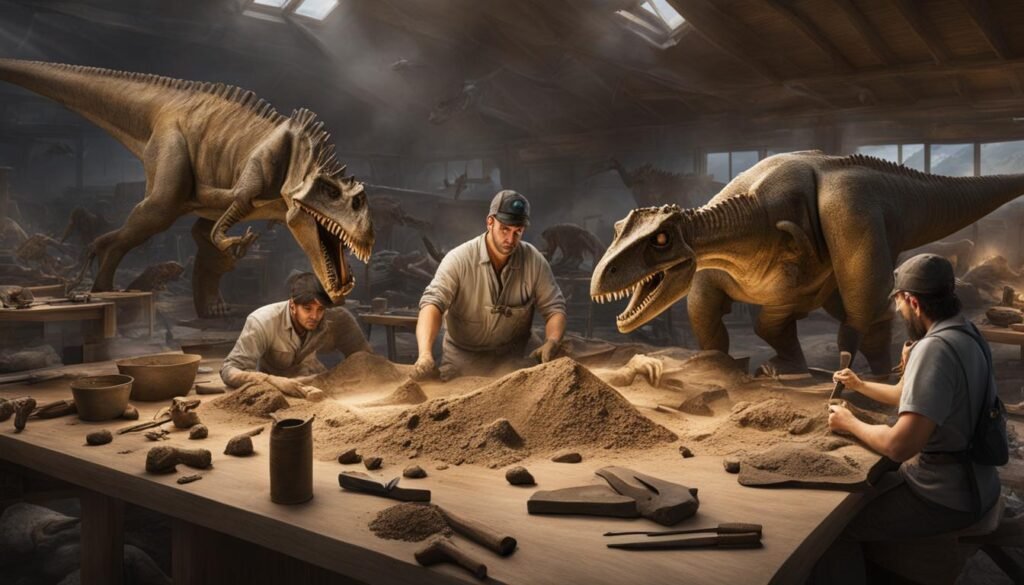
Future Directions in Collaborative Dinosaur Research
The field of collaborative dinosaur research is at the forefront of scientific advancements, driven by the continuous development of technology and increased global collaboration. As scientists strive to uncover more about the prehistoric era, future directions in collaborative dinosaur research hold immense potential. Advancements in technology will play a crucial role in pushing the boundaries of our knowledge.
One of the key future directions in collaborative dinosaur research is the further development of imaging techniques. Advanced CT-scanning methods will allow scientists to obtain even more detailed and precise data from dinosaur fossils. This advanced imaging technology will provide researchers with a wealth of information about dinosaur anatomy, contributing to a deeper understanding of their physical structures and evolutionary adaptations.
Another exciting area of future development is the integration of virtual reality (VR) and augmented reality (AR) technologies in dinosaur research and education. By creating immersive and interactive experiences, VR and AR can greatly enhance our understanding of dinosaurs. Researchers and enthusiasts alike will be able to explore prehistoric environments, interact with virtual dinosaurs, and gain a deeper appreciation for the scale and complexity of these ancient creatures.
“The integration of VR and AR technologies has the potential to revolutionize the way we study and engage with dinosaurs. It will provide a unique opportunity to experience the prehistoric world in ways we could have only imagined before,” says Dr. Elizabeth Grant, a leading paleontologist involved in collaborative dinosaur research.
Collaborative dinosaur research will continue to flourish, providing new insights into the prehistoric era. Advancements in technology, such as improved imaging techniques and the integration of VR and AR, will drive this field forward, offering exciting opportunities for scientists and enthusiasts alike. As we look to the future, collaborative research will remain a cornerstone of dinosaur science, allowing us to unlock the mysteries of these magnificent creatures and share our discoveries with the world.
Future Directions in Collaborative Dinosaur Research:
- Advancements in imaging techniques, including advanced CT-scanning methods, for more detailed data collection.
- Integration of virtual reality (VR) and augmented reality (AR) technologies for immersive and interactive experiences.
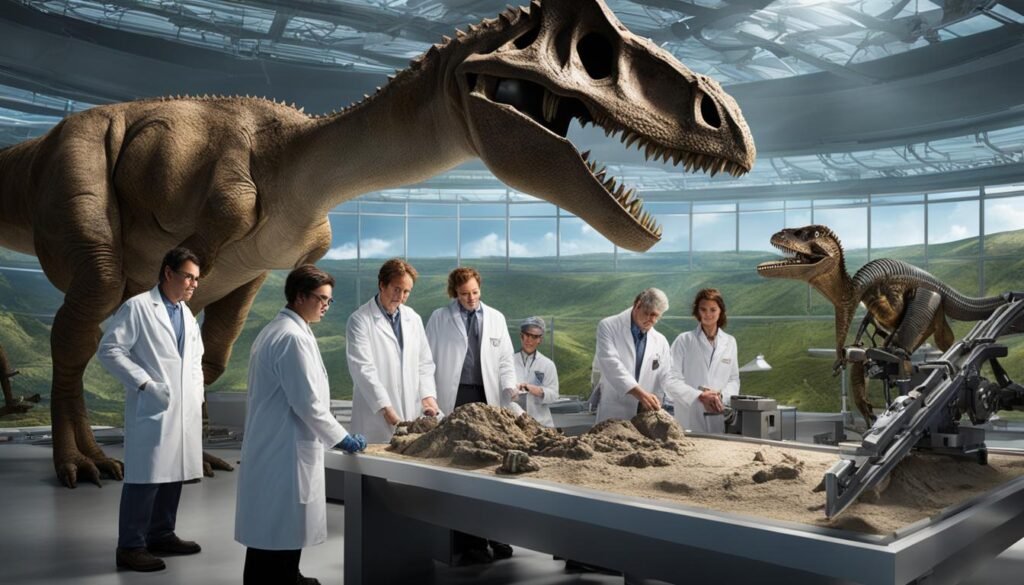
Conclusion
Collaborative International Dinosaur Research Projects have truly transformed our understanding of the prehistoric era. Through the power of global collaboration and the integration of advanced technologies, scientists from around the world have made remarkable strides in deciphering the mysteries of dinosaurs. These projects have not only advanced our knowledge of dinosaur anatomy, paleobiology, and evolution, but they have also fostered the development of robust global dinosaur research networks.
Teamwork lies at the heart of international dinosaur studies. By uniting researchers, institutions, and countries, these collaborative projects have brought together diverse perspectives and expertise, paving the way for groundbreaking discoveries. Through shared knowledge and collaborative efforts, scientists have been able to unravel the intricacies of dinosaur life and shed light on the complex ecosystems that existed millions of years ago.
As we continue onward in our quest to uncover the secrets of the prehistoric world, collaborative research will undoubtedly remain an essential component of global dinosaur studies. Through ongoing teamwork and the exploration of new frontiers, such as advanced imaging techniques and immersive technologies, we will push the boundaries of our knowledge even further. Together, we will continue to unravel the fascinating story of dinosaurs and their extraordinary place in the history of life on Earth.

